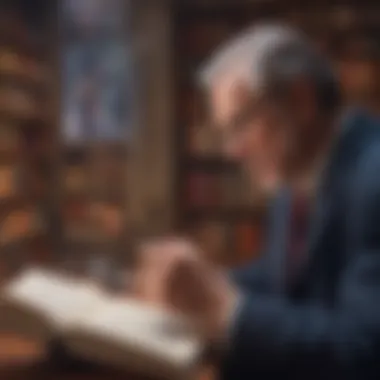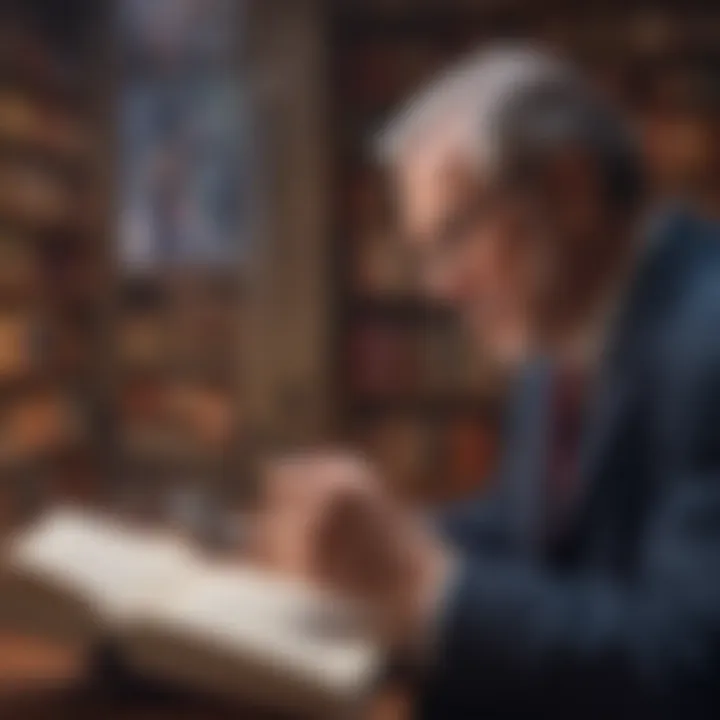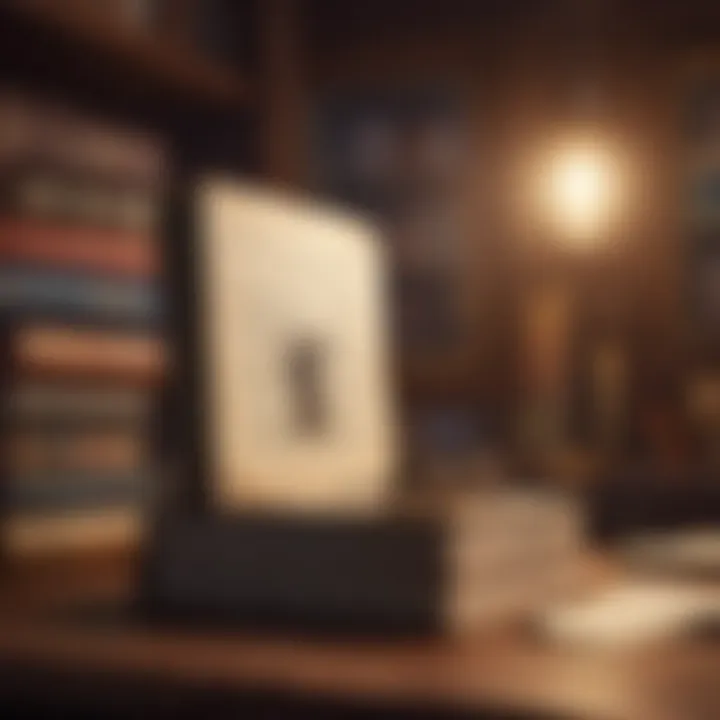Enhancing Literary Comprehension: Insights from Adler


Intro
In our quest to make sense of the world around us, literature stands as a beacon, guiding us through the density of language, ideas, and human emotions. Mortimer Adler's influential work, How to Read a Book, serves not only as a manual for improving reading skills but as an invitation to engage more deeply with texts. This article invites readers, whether students, professionals, or voracious bibliophiles, to explore the layers of insight Adler has woven into his treatise on reading.
Adler's approach unmasks reading as an art, one that requires both practice and persistence. He delineates various levels of reading, pushing readers to elevate their engagement and comprehension from mere superficial consumption to profound understanding. By offering actionable strategies, Adler’s methodologies can transform a simple pastime into a rigorous intellectual exercise.
This article will dissect the core themes of Adler's work, present key quotes, and illustrate the relevance of these insights to contemporary readers who are striving to develop themselves through literature.
Prolusion to Reading as an Art
Reading is often taken for granted as a mere activity, a pastime enjoyed by many. However, the act of reading is far more intricate, a nuanced art that can shape one's understanding of the world. In this article, we will break down how to approach reading not just as a task, but as a skill worthy of refinement. This perspective is crucial as it sets the foundation for appreciating the deeper layers of texts that surface only through intent focus and engagement.
Understanding the Purpose of Reading
To appreciate reading fully, one must first ask: What is the purpose? Many read to relax, escape into different worlds, or simply to keep themselves informed. These reasons are valid, yet they often overlook the profound depths literature offers. Taking a moment to reflect on why we engage with texts can enrich the experience immensely. Each book or article can serve as a bridge to new ideas, perspectives, or challenging concepts that can prompt deeper thinking.
Adler emphasizes that reading should impact a reader’s capacity to think critically. This isn't merely flipping through pages; it’s about grappling with ideas and understanding context. The goal is to move beyond the surface and comprehend deeper meanings, thus transforming passive readers into active participants in their literary journeys. When we grasp that reading can cultivate empathy, stimulate creativity, and enhance critical thinking, we realize it’s an art that deserves mastery.
Significance of Mortimer Adler's Approach
Mortimer Adler offers a methodical framework for tackling the challenging tide of literature. His approach is significant not because it presents revolutionary thoughts but due to its practicality. Adler’s insistence on levels of reading provides clear steps; the process of reading must be systematic and controlled. Here, depth surpasses breadth.
Understanding his techniques encourages readers to engage more thoughtfully, not only with the text but also with their thought processes. By dissecting his insights, readers can ultimately learn how to ask the right questions.
"The reading that you do will affect the way you think, the way you feel, and the way you act. It has the potential to transform your life."
With Adler, the journey becomes a blend of learning and personal growth. The methods he shares are not meant just for scholars; they are for anyone willing to delve deeper into literature. As we navigate through Adler’s teachings, we’ll uncover how these enhancements can lead to a more fulfilling reading experience, changing not just our understanding of texts, but who we are as thinkers and individuals.
Levels of Reading
Understanding the levels of reading is crucial to fully appreciating Mortimer Adler's insights. He stresses that reading is not merely about decoding words; it’s an art that, when practiced wisely, can unlock vast worlds of knowledge and perspective. The multifaceted nature of reading can inform various aspects of personal development, making it easier to discern between different types and depths of thoughts conveyed through literature.
By recognizing the different levels, readers can tailor their approach based on the material and their own objectives, fostering a deeper connection with the text. The importance of these levels cannot be overstated: they encourage readers to engage in a more thoughtful and reflective manner and to develop their own critical thinking skills along the way. This kind of engagement often leads to a more substantial and rewarding reading experience.
The Three Dimensions of Reading
Adler breaks down reading into three dimensions: the literal, the interpretative, and the evaluative dimensions. Each of these dimensions serves a different purpose and addresses a specific aspect of how readers engage with texts.
- Literal Reading: This dimension focuses on understanding the basic information conveyed. It's all about grasping the factual content of the work, such as characters, events, and settings. This foundational level of reading is essential because without it, readers cannot build further meaning.
- Interpretative Reading: Next comes the interpretative dimension, which encourages readers to delve deeper into themes, symbols, and meanings hidden beneath the surface. Here, readers start to recognize multiple interpretations and depend on their analytical skills to piece out complex ideas and contexts that the author presents. Understanding nuances, tones, and underlying messages forms the crux of this level.
- Evaluative Reading: The final dimension brings the reader’s thinking to a higher plane. Evaluative reading involves assessing what one has read critically. Questions arise regarding the author’s arguments, biases, and the credibility of the information provided. Does the author effectively communicate their ideas? Are there logical inconsistencies? Evaluative reading not only cultivates a discerning mind but also allows the reader to engage in discussions with others about the text truly.
In sum, the three dimensions of reading are interrelated; effectively engaging with one often enhances understanding in the others, serving to enrich the overall reading experience.
Active Reading vs. Passive Reading
The distinction between active and passive reading is vital for those who wish to enhance their comprehension and retention of information. Active reading is akin to participating in a dialogue with the text, while passive reading is more like listening inattentively.
Active Reading involves:
- Engaging with the material: Readers make notes, underline significant points, or ask themselves questions about the text.
- Analyzing arguments: Rather than just accepting what is written, an active reader assesses the strength of the author's claims and the evidence presented.
- Reflecting on implications: Considering how the reading applies to personal experiences or existing knowledge leads to a richer understanding.
In contrast, Passive Reading is characterized by:
- Minimal engagement: Readers may skim through without really processing the information.
- Absence of critical thought: Lacking the initiative to question or analyze limits the depth of understanding.
- Poor retention: Without interaction with the text, much of the information can quickly fade from memory.
Engaging in active reading can markedly enhance the effectiveness of the reading process, allowing readers to extract more value from the text. It can turn reading from a chore into a dynamic and rewarding experience, encouraging learners to question, explore, and relate to the literature in unique ways.
"Reading is a form of conversation; the more we participate, the richer the dialogue."
By focusing on these distinctions and dimensions, readers can elevate their approach to literature, ensuring each page read is a step towards deeper understanding and greater intellectual engagement.
The Four Stages of Reading
Reading is more than just moving your eyes across a page; it’s a skill, an art, and a science. Mortimer Adler breaks down this art into four distinct stages, each serving a unique purpose in enhancing one’s understanding of texts. Whether you’re skimming a light novel or diving into a philosophical treatise, these stages are essential in adapting one’s reading technique to fit the material. Understanding these stages equips readers not only to gather information but also to critically engage with it.
Elementary Reading
Elementary reading is the foundation of all reading stages. It’s where everyone starts, often without even realizing it. This stage focuses on decoding words and understanding basic sentence structure. Think of it as the scaffolding of a building; it holds everything together but is not the final structure.


In this stage, the primary goal is proficiency in reading — being able to recognize words fluently and grasp their meanings. It's akin to learning how to ride a bike; at first, it feels awkward. But with practice, it becomes second nature.
Some benefits of elementary reading include:
- Building Vocabulary: As you read, you encounter new words, which enhances your lexicon.
- Improving Comprehension: Understanding the basics helps make sense of more complex texts later.
- Developing Confidence: Mastering this stage instills confidence to tackle tougher material.
Inspectional Reading
Next up is inspectional reading, a pivotal stage for busy individuals and curious minds alike. Here, the objective is to grasp the essence of a text quickly. It’s less about diving deep and more about skimming, scanning, and getting the gist — an invaluable skill for students and professionals dealing with heaps of information.
During this stage, readers engage in two key methods:
- Systematic Skimming: Browsing through titles, headings, and introductory paragraphs to get the main idea.
- Reading for Structure: Understanding how the author organizes thoughts and arguments.
Inspectional reading is useful when:
- Evaluating Relevance: Helps in deciding if a book or article is worth a deeper dive.
- Creating a Mental Map: Gives a bird’s-eye view of ideas presented in the text.
Ultimately, inspectional reading is about effectiveness; the aim is to know enough to determine the worth of what you're engaging with.
Analytical Reading
When you reach analytical reading, that’s when the fun begins. This stage is where readers actively engage with the text, formulating questions and dissecting arguments. Adler posits that analytical reading is essential for true comprehension — a necessity for anyone hoping to understand complex ideas or difficult texts.
At this stage, questions become your best friends. It involves:
- Interrogating the Text: Asking questions like, "What is the author really saying?" or "What are the assumptions behind these arguments?"
- Noting Agreements and Disagreements: It’s crucial to track where you align with or oppose the author’s views.
Analytical reading is a favorite among scholars, philosophers, and anyone looking to gain deeper insights. Benefits include:
- Enhanced Critical Thinking: You develop the ability to evaluate arguments critically.
- Deeper Understanding: Operationalizes the critical engagement of ideas.
Syntopical Reading
The last of Adler’s stages is syntopical reading, the ultimate collaborative form of reading. This stage is about synthesizing insights from multiple texts to create a comprehensive understanding of a topic. Picture it as being a host at a dinner party, where you're not just talking to one person but engaging with everyone, weaving stories and ideas together.
Syntopical reading involves:
- Comparative Analysis: Evaluating how different authors address similar topics or themes.
- Identifying Themes and Patterns: By drawing connections, you’re not only enhancing understanding but also deepening your appreciation for literature as a whole.
The real-world applications of syntopical reading are profound:
- Interdisciplinary Connections: It serves people well across fields — from education to research and beyond.
- Broadening Perspective: Engaging with various viewpoints fosters intellectual development.
Adler's method of syntopical reading is where the magic truly happens, turning passive reception of information into an active pursuit of knowledge.
In summary, each stage of reading, from elementary to syntopical, builds on the last and plays a critical role in refining how we engage with texts. Understanding these stages not only enhances comprehension and critical thinking but also transforms reading into an enriching and gratifying journey.
Adler's Techniques for Effective Reading
Mortimer Adler emphasizes that reading isn't merely a passive act but a dynamic engagement with ideas and thoughts presented in text. His techniques for effective reading aim to transform an ordinary reading session into a profound exploration of content. The importance of this approach lies in its potential to deepen comprehension, stimulate critical thinking, and empower the reader to derive meaning actively, as opposed to simply absorbing information. As students, professionals, and avid readers navigate the sea of literature, discerning Adler's methods can result in a richer reading experience and a clearer understanding of the material.
Adjusting Reading Strategies by Genre
Different genres require different approaches. Adler advocates that effective readers should tailor their strategies depending on the type of text they engage with. This implies recognizing not just the surface level of what’s written but also understanding the underlying intention of the genre itself.
- Fiction vs. Non-Fiction: In fiction, readers often delve into character development and thematic elements, while non-fiction might demand a more analytical approach where information is scrutinized for accuracy and relevance.
- Poetry: This genre invites readers to decipher nuanced phrases, where meaning can shift based on emotional resonance. Techniques here include rereading lines and pondering the layers of meaning contained within.
- Technical Texts: Here, clarity and precision are paramount, thus focusing on understanding terminology and concepts is essential.
Being aware of the genre can help readers approach the material appropriately, paving the way for deeper insights.
Taking Notes and Annotating
Taking notes and annotating are essential components in Adler's reading strategy. This practice serves multiple purposes, which enhance the overall understanding of what one reads:
- Retention: Writing down thoughts helps imprint concepts more firmly in memory. It promotes active engagement with the material.
- Clarification: Jotting down questions or summaries in the margins can help clarify thoughts and make complex ideas more accessible.
- Connection: Making notes allows readers to bridge different ideas across various works, creating a network of knowledge that enriches one’s comprehension.
A good note-taking practice involves minimalism; jotting down key ideas rather than lengthy descriptions adheres to the principle of effectively managing one’s reading resources.
The Role of Questions in Reading


Questions form the backbone of critical inquiry in Adler’s strategy. It is not enough to read a text; readers must also interrogate it.
"To ask questions makes a reader actively participate in the synthesis of knowledge."
Formulating questions activates deeper engagement and fosters critical thinking:
- What is the main argument? Understanding the central thesis allows readers to follow the author's line of reasoning.
- What evidence supports this argument? Analyzing the proofs offered strengthens the critical assessment of the text.
- How does this connect to what I already know? This promotes reflection and synthesis of new and existing knowledge.
Questions lead to more profound insights, allowing readers to confront their perspectives and assumptions. Through this inquisitive lens, readers shift from passive consumers of information to active participants in a dialogue with the text.
By incorporating these techniques into their reading practices, individuals open doors to a more engaging interaction with literature, transforming reading into a multifaceted journey of discovery.
Engaging with Texts
Engaging with texts is more than just flipping through the pages of a book. It's about creating an intellectual dialogue that allows the reader to truly connect with the material. Mortimer Adler emphasizes that reading should be an active process; one should not simply absorb words, but instead ponder and wrestle with ideas. This dynamism forms the core of a robust reading experience, where one’s thoughts bounce off the text like a tennis ball in a match.
Building a Dialogue with the Author
When embarking on a reading journey, envision it as a conversation with the author. Engaging in this dialogue means recognizing the author’s voice, their opinions, and even their biases. It is critical to not just accept what is penned down, but also to interrogate it. Why did the author arrive at this conclusion? What evidence are they presenting?
To effectively enter this dialogue, consider the following:
- Ask Questions: Don’t shy away from your curiosity. If something seems amiss, probe it further. For example, if an author discusses a controversial issue, what evidence do they provide? How credible is that evidence?
- Take Notes: As you read, jot down your reflections. A question here, an insight there. These notes can serve as your side of the conversation.
- Employ Empathy: Try to understand the author’s perspective. What motivated them to write this? Understanding their intent may enrich your understanding of their work.
When one consciously builds this dialogue, it lends the reading experience a rich depth and makes the material resonate more profoundly.
Understanding Authorial Intent
Diving deeper into a text requires understanding why an author has written what they’ve written. Authorial intent is akin to peeling an onion; there may be many layers, with each layer revealing new insights.
Understanding this intent can reshape your reading experience. Consider:
- Context: What was happening during the time the author wrote? External circumstances—like socio-political climates—often influence what gets written.
- Motivation: Every piece of literature has a purpose, whether it’s to inform, persuade, or entertain. Engaging with this thought allows the reader to apprehend the core message more clearly. Ask yourself, "What does the author want the reader to take away?"
- Connection to Other Works: Familiarizing yourself with the author’s previous works can unveil a pattern of thought or recurrent themes, adding a layer of understanding.
In sum, grasping authorial intent forms a pivotal part of engaging with texts, ensuring that the communication is not one-sided.
"Reading is not just about understanding words; it's about connecting and mixing paths with the thoughts behind them.”
When readers engage with texts in this meaningful manner, they unlock avenues for deeper comprehension and personal connection to the material, enhancing both their critical thinking and overall learning experience.
The Interplay of Reading and Critical Thinking
Reading is not merely a passive act of decoding symbols on a page; it's a dynamic interplay between the reader's mind and the text. Mortimer Adler's insights provide a sturdy framework for understanding this connection and underscore the necessity of critical thinking in reading practices. Critical thinking enriches the reading experience, enabling one to dissect ideas, evaluate arguments, and reflect on various perspectives.
Adler emphasizes that reading critically isn't solely about understanding what is being said but questioning how and why it is presented. This critical engagement leads to a more profound appreciation of literature while honing one’s analytical skills.
Formulating Arguments
Formulating arguments is central to Adler's view on engaging with texts. When readers approach a book or article, they should not merely absorb information but actively construct their interpretations. This requires the ability to distill the author's main points, identify supporting evidence, and even recognize biases in the presented material.
Engaging in this process can catalyze the following benefits:
- Cognitive Development: Readers enhance their ability to think logically and sequentially, crafting their lines of reasoning.
- Enhanced Communication Skills: By articulating their arguments, readers sharpen their ability to express thoughts clearly and persuasively.
- Broader Perspectives: Readers learn to consider multiple viewpoints, which enriches their understanding of issues and contributes to a more nuanced point of view.
Incorporating Adler's techniques, such as note-taking and outlining key arguments while reading, can significantly aid in the formulation of personal responses to the text.
Evaluating Information
Adler advocates that the ability to evaluate information is paramount for any reader committed to intellectual growth. With the explosion of information available today, this skill has never been more essential. Evaluating information involves assessing the credibility of sources, understanding the validity of claims, and filtering out misinformation.
Consider these factors for effective evaluation:
- Source Authority: Knowing the background of the author or publisher lends credibility to the material.
- Objectivity: Analyzing whether the information is presented fairly is crucial in discerning fact from opinion.
- Evidence: A careful examination of the supporting data or references enhances understanding and acceptance of the presented arguments.
Adler's critical approach encourages readers to ask questions that challenge the text: What is the author trying to say? What have I learned from this? This reflective practice fosters deeper engagement and enhances one’s ability to think critically.
"The use of books is to give us a world of ideas that we can enter, interact with, and evaluate for ourselves."


The Role of Reading in Personal Development
Reading, often seen merely as an enjoyable pastime, plays a pivotal role in shaping an individual's personal development. As highlighted by Mortimer Adler in his seminal work, the pathways opened by reading are profound, carving out spaces in our minds that enhance both knowledge and critical thinking. The act of reading is not just about ingesting information; it is about nurturing an insatiable curiosity and fostering a mindset open to growth and change.
Fostering a Habit of Lifelong Learning
Embedded in the fabric of reading is the potential for lifelong learning. Embracing reading as a habit encourages individuals to expand their horizons continuously. It is more than flipping through pages; it’s about actively seeking wisdom from diverse genres and authors, enriching one's intellect.
- Variety in Reading: Exploring various genres cultivates versatility in thinking. Delving into fiction can ignite imagination, while non-fiction sharpens analytical skills.
- Regularity and Routine: By setting aside specific times for reading, one can engrain this act as a staple in their daily life. This could be a morning ritual with coffee or an evening wind-down before bed.
- Reflection: Merely reading is not enough; the habit also encourages reflection on the materials consumed. Asking questions about the themes and arguments presented can significantly enhance understanding.
Lifelong learning through reading can minimize cognitive decline, ensuring an agile mind capable of adapting to life's relentless changes. When readers immerse themselves in texts, they cultivate an environment ripe for intellectual stimulation.
The Influence of Reading on Perspective
The impact of reading extends beyond knowledge; it molds our perspectives and shapes our worldviews. Literature serves as a window into different cultures and experiences, providing insights that might otherwise remain locked behind closed doors.
- Empathy Development: Engaging with characters from varied backgrounds fosters empathy. Understanding their motivations and struggles allows one to view the world from perspectives different from their own.
- Critical Analytical Skills: Reading also sharpens one’s analytical abilities. Engaging with complex texts demands that readers dissect arguments and uncover embedded biases, leading to a more nuanced understanding of societal constructs.
- Engagement with Global Issues: Through literature, readers become aware of global challenges that resonate beyond their immediate environments. From climate change narratives to socio-political commentary, these stories fuel informed discussions and promote activism.
"Reading is an act of engagement, a means by which we connect with the wisdom and folly of human experience."
Practical Applications of Adler’s Methods
Applying the methods posited by Mortimer Adler doesn't just linger in the realm of theory; it manifests in tangible benefits for readers willing to dive into literature with purpose. By armed with Adler's insights, readers set themselves on a path toward enhanced understanding and meaningful engagement with texts. These methods are not merely checklists to peruse once and forget. They intertwine with daily experiences, transforming how one navigates not just books but also conversations and ideas in everyday life.
Implementing Reading Strategies in Daily Life
To truly engage with literature, it is essential to integrate Adler’s reading techniques into the daily routine. Start by carving out a dedicated reading time, no matter how short. Fifteen to thirty minutes every day can create a habit that open doors to more profound understanding. This consistency fosters not just routine but also a richer comprehension of the material.
Key Strategies to Implement:
- Set Clear Goals: Decide what you want from your reading—whether to expand knowledge, enjoy a story, or prepare for a discussion. This clarity shapes focus.
- Active Reading Practices: Keep a notebook close by. Jot down questions, reflections, or even confusions as you read. This makes the experience dynamic.
- Choose Wisely: Pay attention to genre. Some texts demand analytical reading, while others might be better suited for inspectional reading. Adjust your strategy accordingly.
The beauty of these techniques lies in their flexibility. Readers must feel empowered to adjust their approach based on their specific needs and contexts. Give yourself the freedom to engage deeply or peruse lightly, depending on your mood or motives.
Collaborative Reading Practices
Sharing the reading experience can open new dimensions of understanding. Collaborative reading, or reading together with others, can provide different perspectives that enrich one’s interpretation of a work. This practice encourages discussions that dive into the meat of a text, moving beyond mere summaries toward a genuine exchange of insights.
Techniques for Effective Collaborative Reading:
- Book Clubs: Joining or forming a book club can expose you to materials and viewpoints you might not encounter alone. Engaging discussions often spark new ideas.
- Online Forums and Groups: Websites like Reddit or dedicated book communities on Facebook allow readers to share thoughts and analyses. This can strengthen your understanding while broadening your literary horizons.
- Study Groups: If you're tackling complex texts for school or work, gather a few peers to discuss themes and arguments. Engaging with others can clarify confusions and deepen insights.
Reading in collaboration creates a rich tapestry of understanding that one cannot achieve in isolation—it’s like having multiple lenses through which to view a single story.
“Reading is a conversation. All books talk. But a good book listens as well.” - Mark Haddon
In essence, the practicality of Adler’s methods lies in the fusion of personal reading habits with collaborative efforts. As students, professionals, or avid readers, these approaches heighten the benefits garnered from literature, reshaping reading from a solitary activity to a community-driven exploration of ideas. Following these strategies allows one to not just read, but to converse, inquire, and grow.
The End
Mortimer Adler’s insights in "How to Read a Book" shape the way we understand literature and engage with texts. The conclusion of this exploration emphasizes the profound impact that reading can have on individuals. Beyond mere entertainment, reading serves as a powerful catalyst for critical thinking and personal growth.
Reflecting on the transformative power of reading invites a recognition of how literature can reshape ideas and beliefs. It is through the deliberate practice of reading that individuals can challenge their perspectives, opening themselves to new possibilities. The act of engaging with diverse texts not only deepens comprehension but also enriches emotional intelligence and empathy. In a world full of noise, reading offers a sanctuary for contemplation—a rare chance to pause and ponder the complexities of human existence.
Reflecting on the Transformative Power of Reading
Reading is not just a mechanical process; it is an experience that captivates the mind and soul. Adler argues that reading can start a dialogue with the author, serving as a bridge between thoughts and ideas. Through this interaction, readers can unveil deeper truths about themselves and the world around them.
When we immerse ourselves in literature, we foster a sense of curiosity. This curiosity encourages us to question and explore—qualities essential for lifelong learning. In many ways, literature becomes a mirror, reflecting our values, aspirations, and fears.
Consider the various genres. A novel may reveal the complexities of love and betrayal, while a historical text can offer lessons on resilience and change. Each reading experience is unique, providing insights that resonate on multiple levels. As Adler illustrates, effective reading involves more than just comprehension; it requires a willingness to deeply engage with the content.
Embracing Reading as a Lifelong Journey
Adler not only outlines the methods of reading but also heralds the journey that lies ahead for avid and curious readers. Embracing reading as a lifelong journey means recognizing that every book opens up a pathway to different ideas and cultures. It’s about embracing the growth that occurs as we navigate through various writings—be it fiction, poetry, or non-fiction.
Reading is like planting seeds of thought. Each book nurtures perspective, and with time, these perspectives fruit into wisdom. That wisdom shapes our conversations, actions, and ultimately, our lives.
The habits we cultivate while reading can lead to a richer, more informed existence. This journey holds the potential for both enlightenment and empowerment, especially in this era where critical thinking is more crucial than ever. By inserting ourselves into a narrative, we don't just passively absorb information; we become active participants in a vast tableau of ideas.
"Books are the quietest and most constant of friends; they are the most accessible and wisest of counselors, and the most patient of teachers." — Charles W. Eliot
As we embrace the art of reading, remember that every encounter with a text holds the potential to change our perspective—engaging our minds and hearts for a lifetime of discovery.
For further reading, check out Wikipedia on Reading, or delve into discussions on Reddit to explore how others experience literature.















